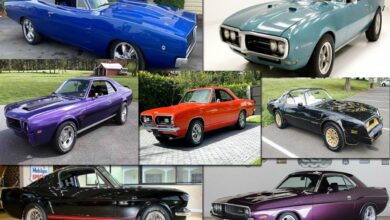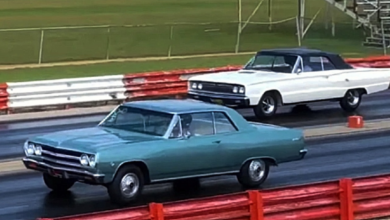1957 Chevrolet Arguably the world’s most popular classic car.
The 1957 Chevrolet was basically a carry-over from the highly successful 1955 and 1956 models. Minor changes included a wide chromed grille, rear tail-fins, and new dashboard. Having both performance and great looks, the 1957 Chevrolets were immensely popular.
After hearing that rival Ford would have an all-new full-size model for 1957, there was concern at Chevrolet. Although GM executives wanted an entirely new car for 1956, production delays necessitated the carry-over of the 1955 design for one more year.
Ed Cole, chief designer for Chevrolet at the time, orchestrated the minor face lift, including the new grille, hood rockets, and front bumper bullets. A relocation of air ducts to the headlight pods resulted in the classic chrome headlight bezels. The face-lifted Chevrolet was ready for sale by October 1956.
Similar to the 1957 Cadillac, the rear fenders got tall but stylish tail-fins. A switch from 14-inch wheels to 15-inch wheels helped give the car a better stance. To help keep the clean lines of the car, the fuel-filler door was concealed in the left rear fin.
The upscale Bel Air series was first offered on two-door Chevy hardtops in 1952. For 1957, the Bel Air package featured gold trim on the front grille, front fender chevrons, and hood and trunk script. The V-shaped trim on the ’57 tail-fins was filled with a ribbed stainless steel insert, which was exclusive to the Bel Air.
Exterior choices included optional two-tone paint schemes and tinted glass. Power steering and power brakes were popular options. Air conditioning was offered on V8-equipped models only.
Inside, power windows and power seats were optional, as was a signal-seeking radio and power antenna. A rear speaker could be purchased which required a separate volume knob installed in the dash. Multi-colored interiors, padded dash, and tissue dispenser were also available.
Mounted to the dashboard, the “Autotronic Eye” sensed the light from oncoming traffic and dimmed headlights automatically.
Because the roof extended so far into the windshield, some found it hard to see overhead traffic lights from the driver’s seat. The traffic-light viewer, a ribbed-plastic visor that sat just above the speedometer, captured the reflection of overhead traffic lights so that the driver didn’t have to lean forward to see past the edge of the windshield.
The base engine for the 1957 Chevrolet was the long-time staple in Chevy’s lineup, the 140-horsepower “Blue Flame Six”.
The relatively simple mechanical attributes of these cars make them easy to maintain, customize, and upgrade with components such as disc brakes and air conditioning. The engine bay is also large enough to fit Chevy big-block engines.








